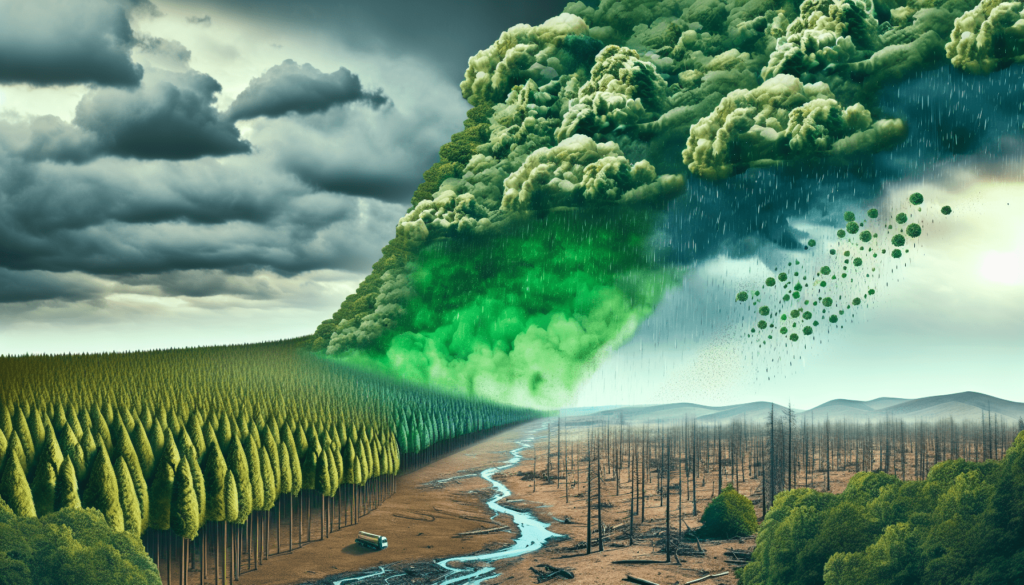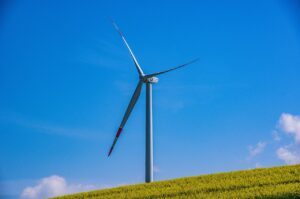When it comes to understanding the intricate relationship between deforestation and climate change, it becomes evident that every tree holds tremendous importance. Deforestation, the outright removal of trees and forests, plays a pivotal role in the disruption of Earth’s delicate balance. This article will shed light on how deforestation impacts climate change, exploring both the immediate and long-term effects of this destructive practice. From increased greenhouse gas emissions to the loss of natural carbon sinks, we will examine the ecological consequences that emanate from the removal of our planet’s vital green cover.

Loss of Carbon Sequestration
Natural Carbon Cycle
The natural carbon cycle plays a crucial role in regulating the Earth’s climate system. It involves the exchange of carbon dioxide (CO2) between the atmosphere, oceans, and land. Forests, in particular, act as significant carbon sinks by actively sequestering carbon through the process of photosynthesis. During photosynthesis, trees absorb CO2 and convert it into oxygen while storing carbon in their biomass and soils. This natural carbon sequestration helps in mitigating the greenhouse effect and stabilizing the global climate.
Impact of Deforestation on Carbon Sequestration
However, deforestation disrupts this natural carbon cycle. When forests are cleared or burned, the stored carbon is released back into the atmosphere in the form of CO2. According to studies, deforestation is responsible for approximately 15% of global greenhouse gas emissions each year. The loss of carbon sequestration due to deforestation not only adds to the concentration of CO2 in the atmosphere but also removes a vital mechanism for mitigating climate change.
Release of Stored Carbon
When trees are cut down or burned, the carbon stored in their trunks, branches, and leaves is rapidly released as CO2. This process not only contributes to greenhouse gas emissions but also eliminates the potential for future carbon sequestration. Additionally, the destruction of forest soils during deforestation releases significant amounts of carbon that had been stored in the form of organic matter. These emissions further exacerbate the impacts of climate change.
Increased Greenhouse Gas Emissions
Burning of Deforested Trees
One of the major contributors to increased greenhouse gas emissions resulting from deforestation is the burning of deforested trees. In many regions, cleared forests are set on fire to clear land for agricultural purposes or to facilitate logging operations. This burning process releases enormous amounts of CO2 and other greenhouse gases into the atmosphere. These emissions not only contribute to climate change but also have detrimental effects on air quality and human health.
Decomposition of Organic Matter
When forests are cleared for agriculture or other purposes, the organic matter in the soil is exposed to decomposition. As a result, the stored carbon in the soil is rapidly released as CO2, contributing to increased greenhouse gas emissions. This process is particularly significant in tropical regions where the decomposition rate of organic matter is high. The loss of this carbon sink further intensifies the impacts of deforestation on climate change.
Reduced Photosynthesis
By removing vast areas of forests through deforestation, we not only lose the carbon sequestration potential of trees but also reduce the overall capacity for photosynthesis. Photosynthesis is the process by which plants, including trees, convert CO2 into oxygen and organic compounds. With fewer trees and vegetation, there is a reduced ability to absorb CO2, resulting in its accumulation in the atmosphere. This imbalance in the carbon cycle contributes to an increase in greenhouse gas concentrations and drives climate change.

Changes in Regional and Global Climate
Altered Water Cycle
Forests play a crucial role in regulating the water cycle by holding and releasing moisture through a process known as evapotranspiration. When deforestation occurs, the water cycle is disrupted, as the capacity of the land to absorb and release water is diminished. This alteration in the water cycle affects regional rainfall patterns, leading to changes in precipitation distribution and intensity. It can result in periods of drought and increased vulnerability to flooding, adversely impacting both human communities and ecosystems.
Loss of Moisture and Evapotranspiration
Forests release moisture into the atmosphere through evapotranspiration. This process involves the combined evaporation of water from leaves and the transpiration of water through plant tissues. Deforestation reduces evapotranspiration, leading to a decrease in atmospheric moisture. This decline in moisture content affects cloud formation and weather patterns, thereby altering regional and potentially global climate dynamics.
Impact on Local and Global Temperatures
Forests provide shade and regulate temperature by intercepting sunlight and reducing heat absorption by the ground. When forests are cleared, particularly in tropical regions, the loss of this shading effect can contribute to higher local temperatures. Additionally, the release of greenhouse gases following deforestation further contributes to global warming. These changes in temperature have far-reaching impacts on both local and global climates, exacerbating the challenges posed by climate change.
Loss of Biodiversity
Ecosystem Disruption
Deforestation leads to the loss of habitats and disruption of ecosystems, resulting in a significant loss of biodiversity. Forests are among the most biologically diverse ecosystems on the planet, housing millions of plant and animal species. When forests are destroyed, countless species lose their homes, leading to a decline in biodiversity. The interconnectedness of species within ecosystems means that the loss of one species can have cascading effects on the entire ecosystem, further destabilizing biodiversity.
Habitat Destruction
Forests serve as crucial habitats for a wide range of plant and animal species. When these habitats are destroyed through deforestation, many species lose their homes and are unable to find suitable alternatives. As a result, species face increased vulnerability to extinction. The loss of biodiversity caused by deforestation not only disrupts ecosystems but also has profound implications for the healthy functioning of ecosystems and the services they provide.
Species Extinction
The destruction of forests due to deforestation is a significant driver of species extinction. As habitats shrink or are completely eliminated, many species are unable to adapt to the changing landscape or find new suitable habitats. Consequently, species that are unable to cope with the rapid environmental changes caused by deforestation face an increased risk of extinction. This loss of biodiversity has broader implications for the stability and resilience of ecosystems and hinders our ability to address the challenges of climate change.

Land Degradation
Soil Erosion
Deforestation often leads to soil erosion, a process in which the top layer of fertile soil is washed away or blown away by wind. Trees and their root systems play a crucial role in stabilizing soil and preventing erosion by anchoring the soil in place. When forests are cleared and trees are removed, the protective cover provided by their roots is lost, making the soil vulnerable to erosion. The loss of fertile topsoil not only reduces agricultural productivity but also degrades the overall quality of land.
Nutrient Depletion
Forests act as nutrient stores, with nutrient-rich organic matter being continuously produced through the decomposition of leaves, branches, and other plant materials. When deforestation occurs, this cycle is interrupted, and the removal of trees results in the loss of organic matter. The depletion of nutrients from the soil adversely affects its fertility, making it less productive for agriculture and hindering the natural regeneration of forests.
Reduced Fertility
The loss of trees and disruption of forest ecosystems through deforestation have significant implications for soil fertility. Forests create a cycle of nutrient recycling by replenishing the soil with organic matter through leaf litter and decaying plant material. When forests are cleared, this nutrient supply is severed, leading to a decline in soil fertility. The reduced fertility negatively impacts agricultural productivity and the regrowth of forests, further reinforcing the cycle of deforestation and land degradation.
Increased Flooding and Drought
Altered Rainfall Patterns
Deforestation is known to disrupt rainfall patterns at both regional and global scales. Forests influence the movement of clouds, precipitation rates, and the variability of rainfall. When forests are cleared, particularly in areas with high rates of deforestation, there is a disruption in the water cycle, leading to altered rainfall patterns. This disruption can result in more frequent and intense periods of both drought and flooding, with significant impacts on water availability for human populations and ecosystems.
Lack of Vegetation Cover
Forests play a crucial role in retaining water and preventing excessive runoff by absorbing rainfall and storing it in the soil. Deforestation removes this natural mechanism, exposing the soil directly to rainwater. Without the protective cover of trees and vegetation, rainfall is more likely to result in surface runoff, leading to increased flooding and the loss of valuable water resources. The lack of vegetation cover also decreases the ability of the land to absorb and retain water, exacerbating the impacts of drought.
Higher Runoff and Soil Erosion
Deforestation increases surface runoff, as rainwater flows directly over the cleared land without being absorbed into the soil. This heightened runoff not only contributes to increased flooding but also accelerates soil erosion. As water rushes over the surface, it carries away fertile topsoil, nutrients, and sediments, further degrading the land. The combined effects of increased runoff and soil erosion caused by deforestation have significant implications for both the local environment and downstream communities.

Loss of Indigenous Communities
Impact on Traditional Cultures
Deforestation has profound impacts on indigenous communities who rely on forests for their livelihoods, culture, and identity. Many indigenous cultures have developed a deep connection and dependency on forests, utilizing them for food, medicine, and spiritual practices. When their traditional lands are cleared for logging or agriculture, these communities face the loss of their cultural heritage and way of life. The destruction of forests undermines their ability to maintain their traditional practices and threatens the survival of their cultural traditions.
Displacement and Social Challenges
Deforestation often results in the displacement of indigenous communities from their traditional lands. With their homes and resources destroyed, these communities are forced to relocate, often facing social challenges and marginalization. Loss of access to traditional lands and resources disrupts social structures and traditions, leading to increased poverty and inequality within these communities. The displacement of indigenous communities due to deforestation highlights the need for sustainable practices that prioritize their rights and well-being.
Loss of Traditional Knowledge
Indigenous communities possess a wealth of traditional knowledge and wisdom, accumulated over generations, about sustainable forest management and conservation practices. This knowledge includes techniques for agroforestry, reforestation, and the sustainable use of forest resources. When deforestation occurs, this valuable knowledge is at risk of being lost as indigenous communities are uprooted from their traditional lands and their connection to the forest is severed. The loss of this traditional knowledge hampers efforts to address deforestation and mitigate climate change effectively.
Negative Economic Impact
Loss of Ecosystem Services
Forests provide a wide range of ecosystem services, including clean water, air purification, pollination, and regulation of climate patterns. When forests are cleared, these valuable services are compromised, leading to negative economic impacts. The loss of clean water sources, for example, can impact agriculture, industries, and human health, leading to increased costs for water treatment and decreased productivity. The economic value generated by ecosystem services provided by forests demonstrates the importance of their preservation for sustainable development.
Impacts on Agriculture and Tourism
Deforestation can significantly impact both the agriculture and tourism sectors. Forests often provide favorable conditions for cultivation, with their shade, humidity, and nutrient-rich soils. When forests are cleared for agriculture, the loss of these beneficial conditions can result in reduced crop productivity and increased reliance on synthetic inputs. Similarly, deforestation can negatively impact tourism, particularly in areas known for their pristine forests and biodiversity. The loss of natural landscapes and wildlife habitats diminishes the appeal of these areas, leading to decreased tourist visits and revenue.
Increased Costs for Adaptation
The negative impacts of deforestation on climate change and natural resources necessitate costly adaptations. As the effects of climate change intensify, communities and governments will need to invest in infrastructure, technology, and practices to mitigate the impacts and adapt to changing conditions. The cost of such adaptations, including measures to combat flooding, drought, and habitat loss, can be substantial. The negative economic impact of deforestation highlights the importance of addressing this issue proactively to minimize future costs.
Feedback Loops and Accelerated Climate Change
Positive Feedback Mechanisms
Deforestation contributes to accelerated climate change through positive feedback mechanisms. As forests are cleared, the release of stored carbon results in increased greenhouse gas emissions. These emissions, in turn, contribute to the warming of the atmosphere, further exacerbating climate change. Additionally, deforestation reduces the albedo effect, which refers to the ability of surfaces to reflect solar radiation. Forests have a higher albedo compared to cleared land, meaning they reflect more sunlight back into space. The reduction in albedo due to deforestation results in more solar radiation being absorbed by the Earth’s surface, contributing to increased warming.
Tipping Points
The destruction of forests through deforestation increases the likelihood of reaching tipping points in the climate system. Tipping points are critical thresholds beyond which abrupt and irreversible changes occur. One example of a potential tipping point is the conversion of tropical rainforests into savannahs or grasslands due to deforestation and climate change. Once this shift occurs, it becomes challenging to reverse, leading to significant ecological and climatic transformations. Tipping points in the climate system have the potential to trigger cascading effects and further amplify the impacts of climate change.
Exacerbation of Climate Change Effects
Deforestation exacerbates the impacts of climate change by reducing the Earth’s natural ability to regulate its climate. The loss of forests, with their diverse ecosystems and carbon sequestration capacity, reduces the planet’s resilience to climate change. Additionally, by contributing to increased greenhouse gas emissions, deforestation intensifies the greenhouse effect and global warming. This exacerbation of climate change effects has far-reaching consequences, including rising sea levels, extreme weather events, and ecosystem disruptions, all of which pose significant challenges to human societies.
Mitigation and Solutions
Reforestation and Afforestation
Reforestation and afforestation initiatives are crucial in mitigating the impacts of deforestation on climate change. Reforestation involves planting trees in areas where forests have been cleared, while afforestation involves establishing forests in areas where they did not previously exist. These initiatives help to restore carbon sequestration capacity, promote biodiversity, and provide numerous ecosystem services. Reforestation and afforestation projects should prioritize the planting of native tree species and involve local communities to ensure sustainable management and long-term success.
Sustainable Logging Practices
Sustainable logging practices can play an essential role in minimizing the impacts of deforestation on climate change. Implementing certification systems, such as the Forest Stewardship Council (FSC) certification, ensures that timber is harvested responsibly and without causing excessive harm to the environment. Sustainable logging practices include selective logging, reducing the impact on forest ecosystems, and promoting the regeneration of harvested areas. By adopting sustainable logging practices, we can obtain timber while preserving the integrity and carbon sequestration potential of forests.
Promoting Forest Conservation
Promoting forest conservation is vital for addressing the causes and consequences of deforestation. This includes raising awareness about the importance of forests, supporting community-based conservation initiatives, and implementing policies that protect and conserve forests. Governments can incentivize forest conservation through financial mechanisms, such as payments for ecosystem services or REDD+ (Reducing Emissions from Deforestation and Forest Degradation) programs. By valuing and protecting forests, we can help mitigate climate change, safeguard biodiversity, and ensure the long-term sustainability of our planet.
In conclusion, deforestation contributes significantly to climate change through various mechanisms. The loss of carbon sequestration, increased greenhouse gas emissions, changes in regional and global climates, loss of biodiversity, land degradation, increased flooding and drought, displacement of indigenous communities, negative economic impacts, feedback loops, and acceleration of climate change effects are all interconnected consequences of deforestation. By understanding these impacts and implementing strategies for mitigation, such as reforestation, sustainable logging practices, and forest conservation, we can work towards a more sustainable and resilient future. It is crucial that we take immediate action to address deforestation and preserve our forests for the benefit of both present and future generations. Together, we can make a positive impact in combating climate change and protecting the invaluable resources that forests provide.




